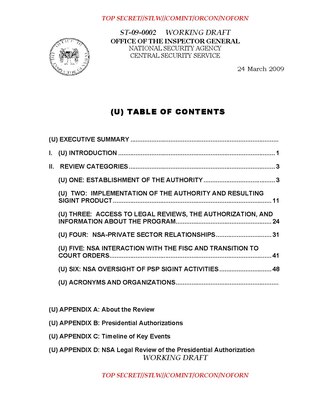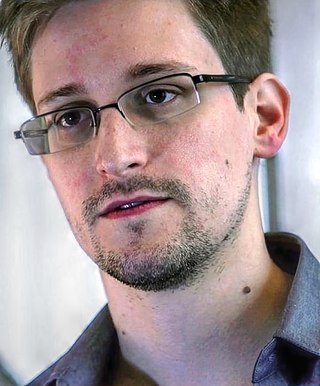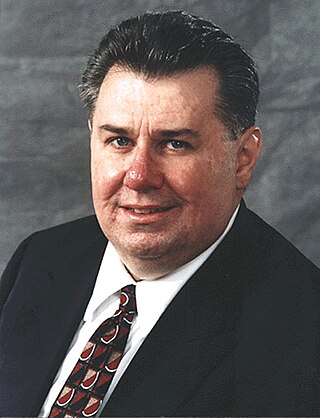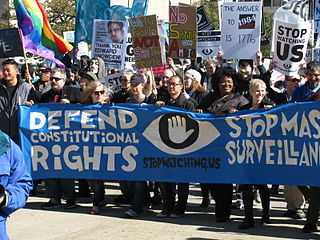 National Security Agency surveillance |
|---|
 |
Global surveillance whistleblowers are whistleblowers who provided public knowledge of global surveillance.
 National Security Agency surveillance |
|---|
 |
Global surveillance whistleblowers are whistleblowers who provided public knowledge of global surveillance.
Perry Fellwock revealed the existence of then ultra secretive National Security Agency (NSA) and its global mass surveillance apparatus and activities, including domestic spying, in a 1971 Ramparts exposé. This was the first wide exposure of the NSA, which had for decades prevented public knowledge of its abilities and activities. The revelations led the U.S. Senate Church Committee to introduce successful legislation intended to stop the NSA spying on American citizens. [1]
In December 2005 Russ Tice helped spark a national controversy over claims that the NSA and the Defense Intelligence Agency (DIA) were engaged in unlawful and unconstitutional wiretaps on American citizens. He later acknowledged that he was one of the sources that were used in The New York Times reporting on the wiretap activity in December 2005. [2] [3] After speaking publicly about the need for legislation to protect whistleblowers, Tice received national attention as the first NSA-whistleblower in May 2005 before William Binney, Thomas Andrews Drake, Mark Klein, Thomas Tamm, and Edward Snowden came forward.
Mark Klein is a former AT&T technician who leaked knowledge of his company's cooperation with the NSA in installing network hardware to covertly monitor, capture, and process American telecommunications en masse. The subsequent media coverage became a major story in May 2006.
In recognition of his actions, the Electronic Frontier Foundation (EFF) picked Klein as one of the winners of its 2008 Pioneer Awards. [4]
For over 22 years Mark Klein worked for AT&T. Starting with the company as a Communications Technician in New York, where he remained from November 1981 until March 1991, he later continued in that capacity in California until 1998. From January 1998 to October 2003, Klein worked as a Computer Network Associate in San Francisco. From October 2003 to May 2004 he returned to the role of Communications Technician, after which he retired in May 2004. [5]
William Binney [6] is a former highly placed intelligence official with the NSA [7] turned whistleblower who resigned on October 31, 2001, after more than 30 years with the agency. He was a high-profile critic of his former employers during the George W. Bush administration, and was the subject of FBI investigations, including a raid on his home in 2007. He came forward with NSA colleagues J. Kirk Wiebe and Edward Loomis, in cooperation with House Permanent Select Committee on Intelligence staffer Diane Roark.
Thomas Tamm is a former attorney in the United States Department of Justice (DOJ) Office of Intelligence Policy and Review (OIPR) during the period in 2004 when senior Justice officials fought against the widening scope of warrantless NSA surveillance that consisted of eavesdropping on U.S. citizens. He was an anonymous whistleblower to The New York Times, making the initial disclosure regarding the issue.
Thomas Andrews Drake is a former senior executive at the NSA, a decorated United States Air Force (USAF) and United States Navy (USN) veteran, and a whistleblower. In 2010 the government alleged that Drake "mishandled" documents, one of the few such Espionage Act cases in U.S. history. Drake's defenders claim that he was instead being persecuted for challenging the Trailblazer Project. [8] [9] [10] [11] [12] He is the 2011 recipient of the Ridenhour Prize for Truth-Telling and co-recipient of the Sam Adams Associates for Integrity in Intelligence (SAAII) award.
On June 9, 2011, all 10 original charges against him were dropped. Drake rejected several deals because he refused to "plea bargain with the truth". He eventually pleaded to one misdemeanor count for exceeding authorized use of a computer; [13] Jesselyn Radack of the Government Accountability Project (GAP), who helped represent him, called it an act of "civil disobedience." [14]
Edward Snowden is an American computer specialist, a former Central Intelligence Agency (CIA) employee, who, while working as a Booz Allen Hamilton contractor, disclosed top secret NSA documents to various media outlets, initiating the NSA leaks, which reveal operational details of a global surveillance apparatus run by the NSA and other members of the Five Eyes alliance, along with numerous commercial and international partners. [15]
The release of classified material was called the most significant leak in US history by Pentagon Papers leaker Daniel Ellsberg. A series of exposés beginning June 5, 2013 revealed Internet surveillance programs such as PRISM, XKeyscore, and Tempora, as well as the interception of US and European telephone metadata, among other disclosures.

Jesselyn Radack is an American national security and human rights attorney known for her defense of whistleblowers, journalists, and hacktivists. She graduated from Brown University and Yale Law School and began her career as an Honors Program attorney at the U.S. Department of Justice.

Russell D. Tice is a former intelligence analyst for the United States Air Force, Office of Naval Intelligence, Defense Intelligence Agency (DIA), and National Security Agency (NSA).

The Terrorist Surveillance Program was an electronic surveillance program implemented by the National Security Agency (NSA) of the United States in the wake of the September 11, 2001 attacks. It was part of the President's Surveillance Program, which was in turn conducted under the overall umbrella of the War on Terrorism. The NSA, a signals intelligence agency, implemented the program to intercept al Qaeda communications overseas where at least one party is not a U.S. person. In 2005, The New York Times disclosed that technical glitches resulted in some of the intercepts including communications which were "purely domestic" in nature, igniting the NSA warrantless surveillance controversy. Later works, such as James Bamford's The Shadow Factory, described how the nature of the domestic surveillance was much, much more widespread than initially disclosed. In a 2011 New Yorker article, former NSA employee Bill Binney said that his colleagues told him that the NSA had begun storing billing and phone records from "everyone in the country."

ThinThread was an intelligence gathering project by the United States National Security Agency (NSA) conducted throughout the 1990s. The program involved wiretapping and sophisticated analysis of the resulting data. The program was discontinued three weeks before the September 11, 2001 attacks due to the changes in priorities and the consolidation of U.S. intelligence authority.

Mark Klein is a former AT&T technician and whistleblower who revealed details of the company's cooperation with the United States National Security Agency in installing network hardware at a site known as Room 641A to monitor, capture and process American telecommunications. The subsequent media coverage became a major story in May 2006. He wrote a book about the NSA and AT&T's cooperation in surveiling everyone on the internet and his experience in discovering it and trying to tell the public called Wiring Up The Big Brother Machine...And Fighting It.
Thomas Tamm is a public defender in Washington County, Maryland. He formerly worked as an attorney in the United States Department of Justice (USDOJ) Office of Intelligence Policy and Review during 2004 when senior Justice officials responded to the warrantless NSA surveillance concerning eavesdropping on U.S. citizens. He was an anonymous whistleblower to The New York Times, making the initial disclosures which led to reporters winning Pulitzer Prizes in 2006. Although Maryland agreed to drop ethics charges against him in 2009 relating to those disclosures, and the USDOJ announced it had dropped its investigation in 2011, the D.C. Office of Bar Counsel announced in January 2016 that it had brought disciplinary charges against Tamm relating to those events. Despite some controversy with respect to politicization of that office and similar charges being brought to silence attorney whistleblowers especially beginning in 2014, Tamm in March 2016 agreed to public censure by the District of Columbia Court of Appeals in order to allow him to proceed with his life and career.

"Stellar Wind" was the code name of a warrantless surveillance program begun under the George W. Bush administration's President's Surveillance Program (PSP). The National Security Agency (NSA) program was approved by President Bush shortly after the September 11, 2001 attacks and was revealed by Thomas Tamm to The New York Times in 2004. Stellar Wind was a prelude to new legal structures that allowed President Bush and President Barack Obama to reproduce each of those programs and expand their reach.

The Sam Adams Award is given annually since 2002 to an intelligence professional who has taken a stand for integrity and ethics. The Award is granted by the Sam Adams Associates for Integrity in Intelligence, a group of retired CIA officers. It is named after Samuel A. Adams, a CIA whistleblower during the Vietnam War, and takes the physical form of a "corner-brightener candlestick".

Trailblazer was a United States National Security Agency (NSA) program intended to develop a capability to analyze data carried on communications networks like the Internet. It was intended to track entities using communication methods such as cell phones and e-mail.

Thomas Andrews Drake is a former senior executive of the National Security Agency (NSA), a decorated United States Air Force and United States Navy veteran, and a whistleblower. In 2010, the government alleged that Drake mishandled documents, one of the few such Espionage Act cases in U.S. history. Drake's defenders claim that he was instead being persecuted for challenging the Trailblazer Project. He is the 2011 recipient of the Ridenhour Prize for Truth-Telling and co-recipient of the Sam Adams Associates for Integrity in Intelligence (SAAII) award.

The Utah Data Center (UDC), also known as the Intelligence Community Comprehensive National Cybersecurity Initiative Data Center, is a data storage facility for the United States Intelligence Community that is designed to store data estimated to be on the order of exabytes or larger. Its purpose is to support the Comprehensive National Cybersecurity Initiative (CNCI), though its precise mission is classified. The National Security Agency (NSA) leads operations at the facility as the executive agent for the Director of National Intelligence. It is located at Camp Williams near Bluffdale, Utah, between Utah Lake and Great Salt Lake and was completed in May 2014 at a cost of $1.5 billion.

Turbulence is a United States National Security Agency (NSA) information-technology project started c. 2005. It was developed in small, inexpensive "test" pieces rather than one grand plan like its failed predecessor, the Trailblazer Project. It also includes offensive cyberwarfare capabilities, like injecting malware into remote computers. The U.S. Congress criticized the project in 2007 for having similar bureaucratic problems as the Trailblazer Project.

William "Bill" Edward Binney is a former intelligence official with the United States National Security Agency (NSA) and whistleblower. He retired on October 31, 2001, after more than 30 years with the agency.

Edward Joseph Snowden is an American and naturalized Russian citizen who was a computer intelligence consultant and whistleblower who leaked highly classified information from the National Security Agency (NSA) in 2013 when he was an employee and subcontractor. His disclosures revealed numerous global surveillance programs, many run by the NSA and the Five Eyes intelligence alliance with the cooperation of telecommunication companies and European governments and prompted a cultural discussion about national security and individual privacy.

Perry Fellwock is a former National Security Agency (NSA) analyst and whistleblower who revealed the existence of the NSA and its worldwide covert surveillance network in an interview, using the pseudonym Winslow Peck, with Ramparts in 1971. At the time that Fellwock blew the whistle on ECHELON, the NSA was a nearly unknown organization and among the most secretive of the US intelligence agencies. Fellwock revealed that it had a significantly larger budget than the Central Intelligence Agency (CIA). Fellwock was motivated by Daniel Ellsberg's release of the Pentagon Papers. Today, Fellwock has been acknowledged as the first NSA whistleblower.
Global surveillance refers to the practice of globalized mass surveillance on entire populations across national borders. Although its existence was first revealed in the 1970s and led legislators to attempt to curb domestic spying by the National Security Agency (NSA), it did not receive sustained public attention until the existence of ECHELON was revealed in the 1980s and confirmed in the 1990s. In 2013 it gained substantial worldwide media attention due to the global surveillance disclosure by Edward Snowden.

Stop Watching Us was a protest effort against global surveillance that culminated in rallies on October 26, 2013.
The German Parliamentary Committee investigation of the NSA spying scandal was started on March 20, 2014, by the German Parliament in order to investigate the extent and background of foreign secret services spying in Germany in the light of the Global surveillance disclosures (2013–present). The Committee is also in search of strategies on how to protect telecommunication with technical means.

Diane Roark is an American whistleblower who served as a Republican staffer on the House Intelligence Committee from 1985 to 2002. She was, right after 9/11, "the House Intelligence Committee staffer in charge of oversight of the NSA". In late 2001, Roark was informed by NSA official William Binney about the Bush administration's domestic surveillance programs, including Stellar Wind. Along with Binney, Ed Loomis, and J. Kirk Wiebe, she filed a complaint to the Department of Defense's Inspector General about the National Security Agency's highly classified Trailblazer Project. Her house was raided by armed FBI agents in 2007 after she was wrongly suspected of leaking to The New York Times reporter James Risen and to Siobhan Gorman at The Baltimore Sun in stories about NSA warrantless surveillance. This led her to sue the government in 2012 for not having returned her computer, which they had seized during the raid, and because the government failed to clear her name. The punitive treatment of Roark, Binney, Wiebe, and Loomis, as well as, and, in particular, then still-active NSA executive Thomas Andrews Drake, who had gone in confidence with anonymity assured to the DoD IG, led the Assistant Inspector General John Crane to eventually become a public whistleblower himself and also led Edward Snowden to go public with revelations rather than to report within the internal whistleblower program.
The same day The New York Times broke the story of the NSA eavesdropping without warrants, Tice surfaced as a whistleblower in the agency. He told ABC News that he was a source for the Times' reporters.